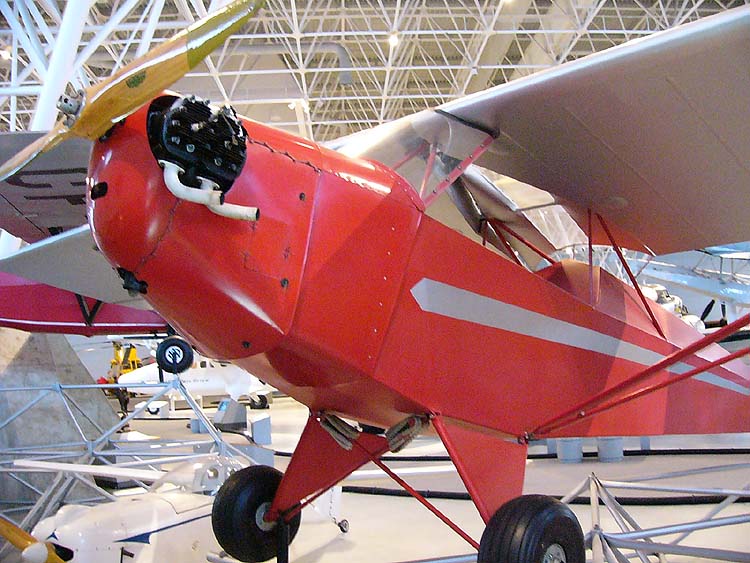- Taylor E-2
Infobox Aircraft
name = E-2 Cub
type = utility
manufacturer =Taylor Aircraft Company 
caption = Taylor E-2 Cub on display at theCanada Aviation Museum inOttawa, Ontario
designer =C. Gilbert Taylor
first flight =September 12 ,1930
introduction =
retired =
status =
primary user =
more users =
produced =1930 -1936
number built = 320
unit cost =
developed from =
variants with their own articles =The Taylor E-2 'Cub' was originally designed by
C. Gilbert Taylor as a small, light and simple utility aircraft. It is the forefather of one of the most popular and best-known light aircraft of all time, thePiper J-3 .History
In 1930, C. G. Taylor and the Taylor Aircraft Company embarked on the production of a two-seat tandem low-powered aircraft, designated the Taylor E-2 (E for the fifth model designed by Taylor, and 2 for the number of seats). The E-2 featured a design with wings mounted high on the fuselage, an open cockpit, fabric-covered tubular steel fuselage and wooden wings which used the USA-35B
airfoil . It was originally powered by a 20horsepower (14.9kilowatt ) Brownback "Tiger Kitten" engine. Since the young offspring of thetiger is called acub , Taylor'saccountant ,Gilbert Hadrel , was inspired to name the little airplane "The Cub".The "Tiger Kitten" engine roared but was not strong enough to power the E-2. On
September 12 , 1930, a test flight of the Taylor E-2 ended abruptly when the aircraft ran out of runway; the underpowered engine was unable to lift the monoplane higher than five feet (1.5 meters) above the ground. In October, a Salmson AD-9radial engine produced inFrance was fitted to the E-2. It gave the Cub good performance, but it was expensive to maintain.Finally in February 1931, Taylor introduced an improved E-2 airframe, powered by the newly developed
Continental Motors 37 horsepower (27.6 kilowatt) A-40 engine. The new Taylor E-2 was awarded Category 2 or "Memo" certificate 2-358 onJune 15 , 1931 and licensed by the U.S. Department of Commerce for manufacture (it was later awarded full Approved Type Certificate onNovember 7 ). Twenty-two Taylor E-2 Cubs were sold during 1931, retailing for $1,325; by 1935, cost had increased to $1475 and by the end of production in February 1936, 320 E-2 Cubs had been built.pecifications (Taylor E-2 Cub)
aircraft specifications
switch order of units?=no
include 'capacity' field?=yes
plane or copter?=plane
jet or prop?=prop
include 'armament' field?=nocrew=1
capacity=1 passenger
length main=22 ft 3 in
length alt=6.78 m
span main=35 ft 3 in
span alt=10.74 m
height main=6 ft 6 in
height alt=1.9812 m
area main=184 ft²
area alt=17.1 m²
empty weight main=556 lb
empty weight alt=252 kg
loaded weight main=
loaded weight alt=
max takeoff weight main=970 lb
max takeoff weight alt=440 kg
engine (jet)=
type of jet=
number of jets=
thrust main=
thrust alt=
engine (prop)=Continental A-40-2
type of prop=
number of props=1
power main=37 hp @ 2550 RPM
power alt=28 kWmax speed main=61 kt
max speed alt=70 mph, 113 km/h
cruise speed main=54 kt
cruise speed alt=62 mph, 100 km/h
range main=156 nm
range alt=180 mi, 290 km
ceiling main=12,000 ft
ceiling alt=3,700 m
climb rate main=400 ft/min
climb rate alt=2.0 m/s
loading main=5.03 lb/ft²
loading alt=24.6 kg/m²
thrust/weight=
power/mass main=25 lb/hp
power/mass alt=16 kg/kWarmament=
Taylor F-2
Approved Type Certificate A-525 for the Taylor F-2.
Persistent troubles with the early A-40 engines on the E-2 led to a search for other suitable powerplants. First choice was the
Aeromarine AR-3-40, a three-cylinder air-cooled radial engine which produced 40horsepower at 2050 RPM. Due to Bureau of Air Commerce policy at the time, a different engine in the same airframe required a new airplane model designation. The Aeromarine-powered Cub was given the next letter, F, and became the F-2.Approved Type Certificate was awarded on
February 16 , 1934, and the F-2 had an initial price of $1495. Approximately 33 were made before a factory fire in 1937 ended production of the F-2.Taylor G-2
In another search for a replacement for the A-40, Taylor went to the extreme of designing and building his own 35-40
horsepower engine. This was fitted to serial number 149, registration X14756. Again, due to Bureau of Air Commerce policy at the time, a different engine in the same airframe required a new airplane model designation. The Taylor-powered Cub was given the next letter, G, and became the G-2.No information was published about the one-off engine, and no details are known today. With a new engine, this aircraft would become the Taylor H-2.
Taylor H-2
The G-2 Cub was re-engined with a 35
horsepower Szekely (pronounced Say-Kai) SR-3-35, another three-cylinder air-cooled radial engine which produced 35 hp at 1750 RPM. Again, due to Bureau of Air Commerce policy at the time, a different engine in the same airframe required a new airplane model designation. The Szekely-powered Cub was given the next letter, H, and became the H-2.Approved Type Certificate A-572 was awarded on
May 28 , 1935. Three F-2's were converted to this engine (serial numbers 40, 66 and 74), for a total of four H-2's.In 1937, Beverly Dodge and a passenger set the women's altitude record (16,800 feet) in a Szekely powered Taylor H-2.
References
*
* [http://www.centennialofflight.gov/essay/GENERAL_AVIATION/piper/GA6.htm "The Piper Cub"] by Roger Guillemette, "US Centennial of Flight Commission", retrieved December 6, 2005
* [http://www.oldrhinebeck.org/collection/engines/Szekely%20SR-3%20L.htm "Szekely SR-3 L"] "Old Rhinebeck Aerodrome", retrieved December 6, 2005External links
* [http://www.airminded.net/e2/e2.html Taylor E-2 Cub - Holcomb's Aerodrome]
* [http://www.taylorcraft.com/?view=cub_standard Taylor Cub] - A version of the original E-2 Cub manufactured by theTaylorcraft Companyee also
aircontent
sequence=related=
*Taylorcraft Taylor Cub
*Piper J-3 similar aircraft=
*Aeronca C-2 lists=
see also=
Wikimedia Foundation. 2010.
